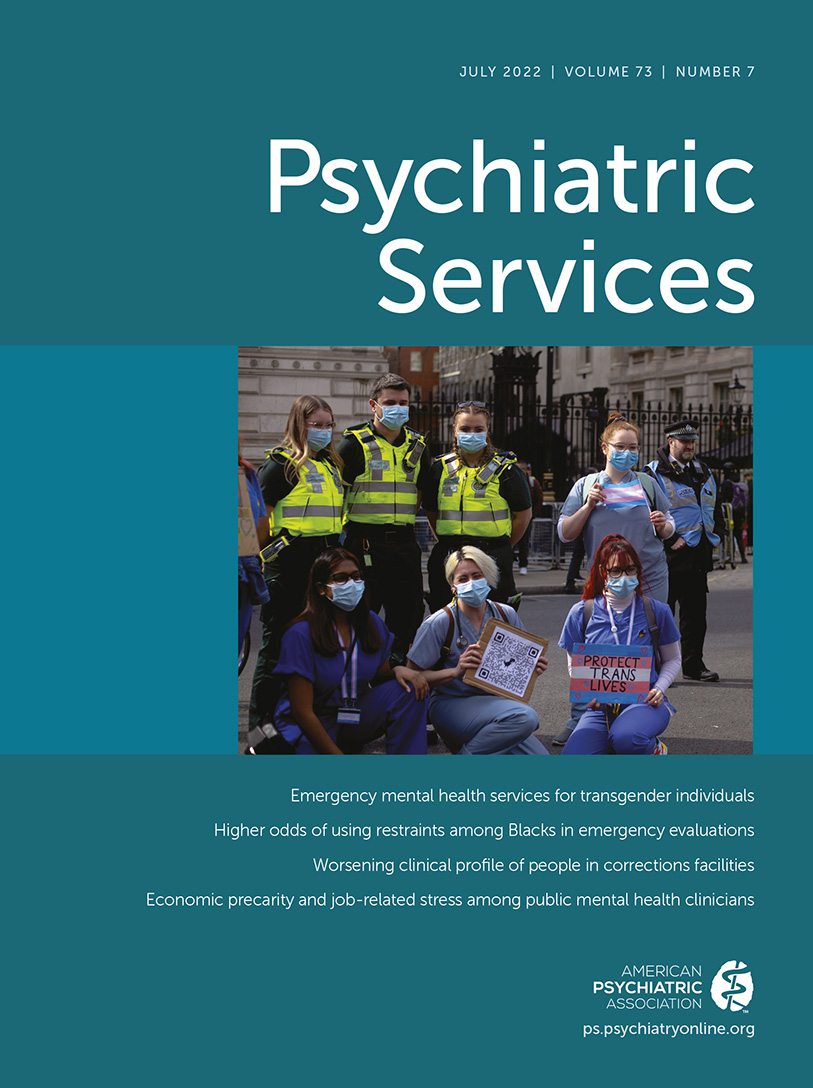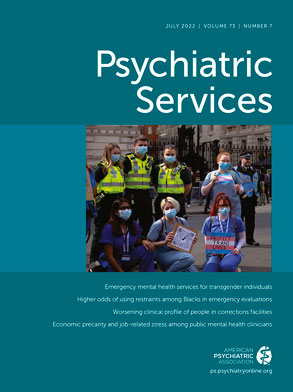One night in August 2019, Elijah McClain, a 23-year-old Black massage therapist, left his residence in Aurora, Colorado, to walk to a nearby convenience store in search of iced tea. As he was returning home, someone contacted the police to report a “sketchy”-looking person walking down the street, wearing a ski mask and waving his arms. Responding to the call, three Aurora police officers stopped McClain. When he told them, “I have a right to go where I am going,” they threw him to the ground and used a choke hold to reduce blood flow to his brain. Paramedics soon arrived on the scene and, concluding that McClain was experiencing “excited delirium,” injected him with a large dose of ketamine, a powerful sedative used primarily as an anesthetic. Shortly afterward, McClain suffered a cardiac arrest, and he died three days later (
1).
Although authorities initially declined to press charges against the officers, all three of whose body cameras conveniently fell to the ground during the encounter, extended public protests and national media coverage forced a reconsideration. In January 2021, the three police officers, along with the two paramedics who failed to evaluate McClain and injected him with a dose of ketamine twice as large as indicated given his weight, were indicted on a variety of charges, including manslaughter and criminally negligent homicide (
2). Were Elijah McClain’s death an anomaly, it still would have been a tragedy for him and his family. But the diagnosis of excited delirium—a questionable term lacking clear criteria—has been used nationwide to justify the use of ketamine and to explain deaths in police custody, especially the deaths of young Black men like Elijah McClain.
What Is Excited Delirium?
The term “excited delirium” was first popularized in 1985, when it was used to describe the cases of seven people who died while intoxicated with cocaine—five of whom died in police custody (
3). Characteristics of excited delirium were said to include “fear, panic, shouting, physical violence, hyperactivity, and thrashing” (
3), along with unexpected strength and hyperthermia. Although it was not recognized as a formal diagnosis by either the American Psychiatric Association (APA) in the
DSM or the World Health Organization in the
ICD, excited delirium became popular among medical examiners as an explanation for deaths that occurred in police custody. The term has been used to exculpate police officers from responsibility for fatalities of people in their charge, including suspects who were tasered and later died (
4).
As a 2021 report from the Council on Science and Public Health of the American Medical Association (AMA) made clear, the diagnosis of excited delirium has persisted despite “a lack of scientific evidence, a universally recognized definition, a clear understanding of pathophysiologic mechanisms, or a specific diagnostic test,” yet “law enforcement and [emergency medical services] personnel are taught that [excited delirium] is a potentially deadly medical condition” (
5). Of all U.S. medical associations, only the American College of Emergency Physicians (ACEP), whose members often supervise paramedics in the field, has embraced the diagnosis. However, an ACEP white paper that endorsed excited delirium conceded, “It has generally been used to describe a small group of patients with a set of symptoms that has eluded a unifying, prospective clinical definition” (
6).
Concerns about the use of the diagnosis have intensified because of the oddity of the symptoms said to be associated with excited delirium and the potential bias that these symptoms may reflect. In addition to the core symptom of agitation, a 2018 systematic review noted symptoms and signs that included hypervigilance, fear, unusual or unexpected strength, imperviousness to pain, noncompliance with commands of the police, disrobing, and attraction to reflective surfaces (
7). Notably missing from the list of criteria for the diagnosis is any reference to delirium, which the
DSM defines as “a disturbance in attention (i.e., reduced ability to direct, focus, sustain, and shift attention) accompanied by reduced awareness of the environment,” with a concomitant cognitive disturbance.
In the hands of police officers, who often make the initial determination that a person being detained is in a state of excited delirium and call emergency medical services for support, this heterogeneous symptom list affords discretion to describe the condition of almost any agitated, uncooperative person as excited delirium. Several of these characteristics, such as unusual strength and imperviousness to pain, appear to justify the use of extreme measures for physical restraint, such as those applied by the three police officers who tackled and choked Elijah McClain. Furthermore, several of these symptoms reflect stereotypes of young Black men, to whom this diagnosis is disproportionately applied (
4). Indeed, one study of deaths in police custody from 2010 to 2020 reported to be caused by excited delirium found that, in 43.3% of cases, the deceased person was Black and that the person was almost always male (
8).
In reaction to the indiscriminate use of a term that sounds like—but is not—a formal diagnosis, in late 2020 APA issued a position statement calling for systematic research on the use of the term “excited delirium.” The statement noted, “The term ‘excited delirium’ is too nonspecific to meaningfully describe and convey information about a person. ‘Excited delirium’ should not be used until a clear set of diagnostic criteria are validated” (
9). AMA followed suit in 2021, resolving “that current evidence does not support ‘excited delirium’ or ‘excited delirium syndrome’ as a medical diagnosis, and [AMA] opposes the use of the terms until a clear set of diagnostic criteria are validated.” AMA also expressed concern that “law enforcement officer use of force accompanying ‘excited delirium’ . . . leads to disproportionately high mortality among communities of color, particularly among Black men” and denounced use of the term as a justification for the use of force by law enforcement (
10). Even ACEP appears to be backing away from its endorsement of the alleged syndrome; its most recent task force report instead uses the term “hyperactive delirium,” which is a
DSM category with defined criteria, and notes that members of the previous ACEP group who wrote the 2009 white paper had been criticized for bias (
11).
The Role of Ketamine
It was not by chance that the drug administered to Elijah McClain was ketamine, a dissociative anesthetic with powerful sedative properties. Used at a much higher dosage than it is for psychiatric indications, ketamine has become the sedative of choice for people who are said to have excited delirium. Studies suggest that ketamine works more rapidly than other sedative medications, which has contributed to its popularity (
11). Ketamine is also often said to have a lower rate of respiratory depression than alternative drugs that achieve the same level of sedation, such as benzodiazepines. However, as data on ketamine use in the field have accumulated, it has become clear that a substantial proportion of people who receive ketamine later require intubation. Both laryngospasm and hypersalivation are common side effects of ketamine, and both can interfere with respiration. A systematic review found a 20% rate of intubation (
12), although some studies have reported that over 60% of people who received ketamine were subsequently intubated (
11).
When deaths occur after administration of ketamine, it is often difficult to identify the cause. Agitated people in police custody frequently have been taking drugs and are typically subjected to forceful restraint, such as the choke hold used with Elijah McClain, who begged police to let him breathe. They may also be tasered, which involves a device that has also been associated with unexplained deaths. Clarifying the intertwined impacts of police restraints, underlying conditions, and ketamine or other sedating medications may be extremely difficult. As an exception that may prove the rule, in the highly publicized case of George Floyd, who was also said to have excited delirium, it was only the availability of video evidence that allowed investigators to identify that the cause of death was an officer’s knee held on Floyd’s neck for a prolonged period (
13). It is clear that the suggestion that the death of a person in police custody was caused by excited delirium has often been used to absolve police officers of responsibility for their behavior (
8).
Paramedics called to the scene by law enforcement are usually the ones who administer ketamine to uncooperative people detained by the police. State departments of public health may authorize the use of ketamine by paramedics outside hospital settings and without a physician on the scene. As is clear from several cases in which body camera evidence exists, on paramedics’ arrival, the police may inform them that the detained person has excited delirium and may implicitly or explicitly request that the person be sedated. In some cases, the detained person is already restrained and calm but receives the drug anyway. Although paramedics are supposed to perform an independent evaluation of the need for medication before administering it, that assessment did not happen in the case of Elijah McClain. Indeed, one Minnesota paramedic reported that police officers sometimes informed him on his way to the scene that he should have a syringe of ketamine drawn up; on an occasion when he refused to administer the drug because he did not think it was indicated, he was told by his superiors that he had been insubordinate in refusing the police request (
14). For paramedics, who work closely with police officers and may depend on them for protection in difficult situations, declining to administer ketamine, even when it is clearly not indicated, understandably may be difficult.
The Aftermath of the Death of Elijah McClain
The publicity garnered by the McClain case, sparked by the public protests that followed the district attorney’s initial decision not to prosecute the police officers involved, has brought increased attention to the problematic use of the term “excited delirium” and to the administration of ketamine that so often accompanies it. In Colorado, a new statute bars the use of ketamine for excited delirium or any psychiatric indication and prohibits the police from attempting to influence a decision to use ketamine. Paramedics are also required to seek a verbal order from their supervising physician before administering the drug (
15). Other states have also begun to examine their procedures. Meanwhile, the McClain family settled a lawsuit against the city of Aurora for $15 million. Multiple medical organizations, including APA (
9), have spoken out, rejecting the use of any medication for sedating people in police custody merely to make them easier to control.
Law enforcement officers routinely interact with people who are in distress, behave oddly, and fail to comply with their orders. The difficulty of handling such situations should not be underestimated. However, in many cases, the availability of emergency medical services personnel authorized to administer sedating medications has become too easy a recourse for the police, who too often decline to attempt the use of standard techniques to de-escalate the situation. The sad result has been needless deaths because of situations that should never have occurred.

